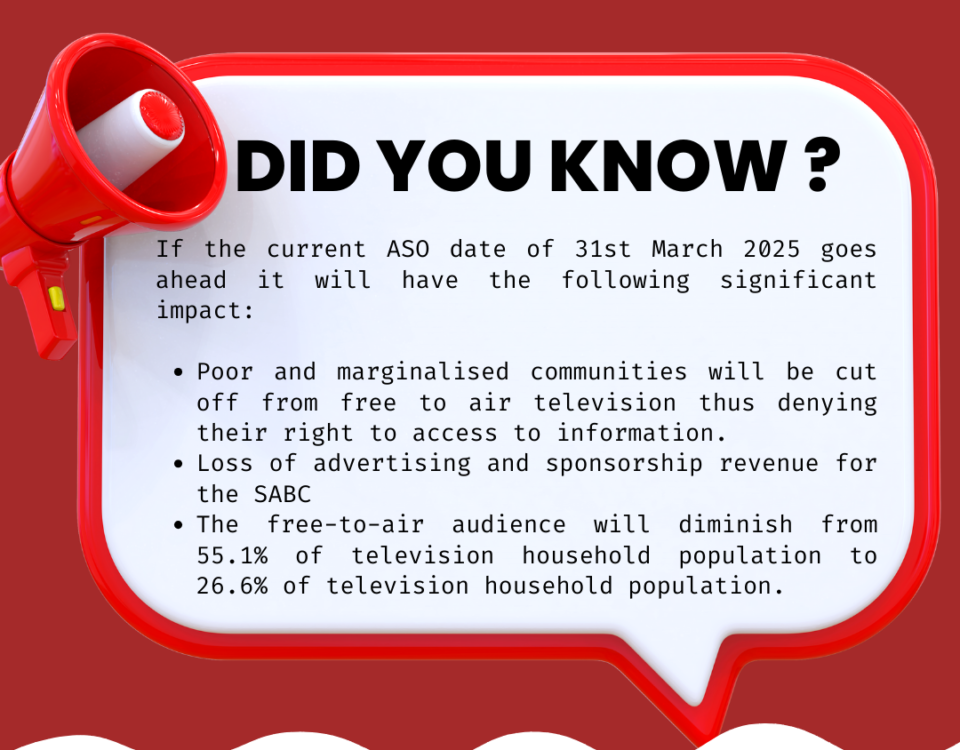
ICASA 2014 South African Local Content Discussion Meeting for Independent TV Production Industry
September 22, 2014Written Representations on USAASA’s Qualifying Criteria for the STB Scheme of Ownership
November 28, 2014Letter to Minister of Communications Concerning Conditional Access for Set-Top Boxes
Dear Minister,
RE: Regarding Conditional Access for Set-Top Boxes
We are concerned about the future of free-to-air television in South Africa if a conditional access system is not implemented in set-top boxes (STBs) in the digital terrestrial television (DTT) environment.
Although the issue may seem to be merely a technical matter, it has implications for the ability of free-to-air television to compete with pay-TV in the DTT environment. Pay-TV operators in South Africa have CA embedded in their STBs, which they use to secure the content which they deliver to the TV screens of their subscribers.
The key factor for the success of the migration from analogue television broadcasting to DTT is the value of the content which will be provided through STBs. At present digital television content providers are limited to the pay-TV operators, which each have their own dedicated STBs through which subscribers access their services. The DTT STB will be another ‘box’ on the market and will be competing with the pay-TV services by virtue of the content ‘bouquet’ which it offers as well as on the cost of access.
While the public will have to invest in DTT STBs in order to receive DTT services, many of these STBs will be subsidized by government, which represents an investment by the state in the right of its citizens to receive information. STB purchase costs will be a once-off investment, after which the free-to-air channels will be received without the monthly payments necessary for subscription services.
A conditional access system is necessary here because it will ensure the following:
Good quality content – licensing of HD content, such as the latest Hollywood movies, is dependent on the ability of broadcasters to secure that content against piracy. CA is one method of achieving this because the broadcast signal is scrambled, which prevents signal piracy – although it doesn’t prevent copying of the content once it has been received, which would require a digital rights management (DRM) system.
A standard user interface to facilitate effective support – with a CA system in place, all STBs would have the same user interface. This means that it will be easy to inform viewers how to use the interface and solve whatever problems they might encounter with the service. If there are a variety of interfaces, which will be the case if non-SABS compliant boxes – or ‘grey’ imports – support will be much more complicated and expensive.
Developing the South African manufacturing and electronics industry – South African companies will be best placed to manufacture STBs for use in the South African market because they will be authorised to support the CA software. Encryption will prevent the flooding of South Africa with cheap foreign imports because these will not be able to unscramble encrypted broadcast signals.
Broadcast Digital Migration is a once-in-a-lifetime opportunity for the SA consumer electronics industry to develop because it creates a unique economy of scale to justify larger investments. This will have a massive and sustainable impact on job creation and skills development. There are already a number of companies in South Africa which have developed their own STB design and more will follow if the sector is not compromised by interference from cheap, non-compliant imports which will cause problems for both users and service providers.
The STBs will be addressable – in other words each one will have a unique serial number which will enable the box to receive personalized messages. This will enable government for example to send messages to individual households in their language of choice.
Free-to-air broadcasters can protect their content against unauthorized use. Without encryption, any set top box launched by any pay-TV operator will be able to simply pick up the signals of the free-to-air channels off the air without paying the other broadcasters. The pay-TV providers can use the presence of the free-to-air channels on their STBs to drive sales on the backs of the free-to-air services, which are the most-watched channels in South Africa, even on the pay-TV platforms.
Additional cost – much has been made by the opponents of CA that it would add significant (and unnecessary) costs to the migration, both to the user and to government. There are arguments both for and against this position – but there is a pressing need to accelerate the migration process due to international treaty obligations and the need to free-up radio frequency spectrum to make way for telecommunications and data services, and having a uniform, easily upgradable base of CA-enabled STBs will ease the transition process.
Enhancing the move towards integrated digital TV sets (IDTVs) – these devices are already in use and obviate the need for an STB because they are able to receive the digital television signal. Opponents of CA say that encryption will hinder the uptake of IDTVs – but the impact of encryption will have a negligible impact because STBs are a fact of life for television viewers today. For instance all pay TV viewers have STBs and will continue to do so. STBs can add value through added features, for example they can be used to store content for later viewing.
We are mindful of the judgment of the South Gauteng High Court which placed the power of decision-making regarding signal encryption in the hands of free-to-air broadcasters rather than government. However studies have shown that the implementation of CA systems in other countries where DTT has been initiated has helped to facilitate the uptake of DTT services. We therefore support government’s decision to implement a CA system in STBs, which will allow subscription and free-to-air broadcasters the freedom to use it if they so choose.
Yours sincerely,

